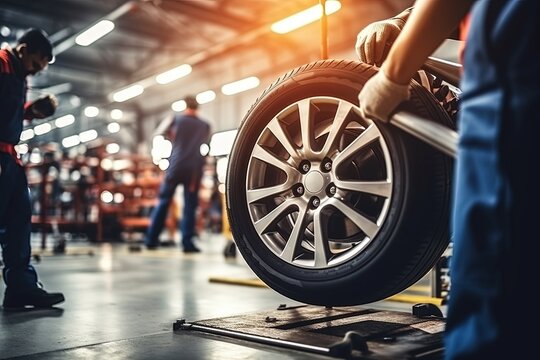Your tires are like shoes. If you wear the same pair on the same feet every day, the heels wear out weird. Rotating = swapping tires around so they all share the work and last longer.
Rotating your tires helps achieve even tire wear, which improves handling, traction, and extends the overall lifespan of your tires.
The big wins (aka why this matters)
- Longer tire life: Even wear = more miles before you have to buy new rubber. Replacing worn tires with new tires is necessary to maintain safety and optimal performance.
- Safer stopping + better grip: Fresh, even tread and even tread wear = shorter stops and more control in rain/snow, improving traction and handling.
- Quieter ride: Prevents that “whomp-whomp” noise from uneven wear.
- Protects AWD systems: On AWD, big tread differences between tires can stress the driveline.
- Keeps warranties valid: Many tire warranties require proof of regular rotations.
How often should you rotate?
- Good rule: Rotate your tires every 5,000–7,500 miles or every 6 months, whichever comes first.
- Sync it with oil changes so it’s easy to remember.
- If you tow, drive lots of city miles, or run aggressive tires, rotate on the earlier side.
Always check your vehicle's manufacturer's recommendations for the most accurate tire rotation interval and pattern.
Rotation patterns (simple + practical)
- FWD (most cars): On a front wheel drive vehicle, the front wheels experience more wear. Use a forward cross tire rotation pattern: the front tires are rotated straight back to the rear axle, and the rear tires are crossed to the front axle. This ensures even wear across both the front and rear axles.
- RWD: For rear wheel drive vehicles, use a rearward cross tire rotation pattern: the rear wheels are rotated straight to the front axle, while the front wheels are crossed to the rear axle.
- AWD/4×4: Many shops use an X-pattern when rotating tires so every tire is positioned on both front and rear axles over time, ensuring even wear.
- Directional tires (arrow on sidewall): These tires are designed to roll in one direction. Rotate front to rear on the same side only; do not cross sides.
- Staggered setups (different sizes front/rear): Only tires on the same axle can be swapped side to side (and only if non-directional).
Proper tire rotation maintenance involves following the correct tire rotation pattern for your vehicle’s front and rear axles. Each tire, including the left front tire and rear left tire, should be positioned according to the recommended pattern and rotated as specified. The left tire and rear axles require special attention in some rotation patterns to ensure even wear. Following the correct tire rotation pattern helps prevent uneven wear on the same axle.
Pro move: check your owner’s manual—some models specify a unique pattern.
Tire rotation tips
Want to get the most out of your car tires? Here are some tire rotation tips to help your tires wear evenly, boost traction, and keep your ride safe and smooth—no matter what you drive.
- Know your drive type: For rear wheel drive vehicles, rear tires often wear faster because they handle more of the power and torque. Regular tire rotation is key to preventing uneven tire wear and keeping braking performance sharp. On front wheel drive vehicles, it’s the front tires that take the most abuse, so rotating them with the rear ones helps balance out the wear.
- Use the right rotation pattern: For front wheel drive vehicles, the “Forward Cross” pattern is your friend—move the front tires straight back, and the rear tires diagonally to the front. For rear wheel drive vehicles, try the “Rearward Cross”—rear tires go straight to the front, and front tires cross to the rear. All wheel drive vehicles benefit from patterns that let all four tires visit every position over time.
- Check tire pressure: Before and after you rotate your tires, make sure each tire is inflated to the manufacturer’s recommended pressure. Proper tire pressure helps tires wear evenly and improves both traction and fuel efficiency.
- Inspect tread depth: While rotating, check the tread depth on all four tires. Uneven or excessive wear can signal issues with your suspension system or wheel alignment. Catching these early means safer driving and longer tire life.
- Mind your alignment: If your tires aren’t aligned properly, even the best rotation pattern won’t save you from uneven tire wear. If you notice your steering wheel pulling or your tires wearing unevenly, have a tire technician check your wheel alignment.
- Don’t forget torque: When reinstalling your wheels, always torque the lug nuts to the correct specification. This keeps your wheels secure and prevents damage to critical parts.
- Stick to a schedule: Regular rotation—every 5,000 to 7,500 miles, or as recommended by your vehicle’s manufacturer—helps all four tires wear evenly and extends their lifespan.
Pro tip: Always consult your owner’s manual for the best rotation pattern and schedule for your specific vehicle. And if you’re ever unsure, a professional tire technician can help you rotate your tires, check for uneven wear, and make sure everything’s aligned properly.
By following these tire rotation tips, you’ll enjoy better traction, improved braking, and a smoother, quieter ride—plus, you’ll save money by making your tires last longer.
Signs you need a rotation now
- Feathering or cupping on tread blocks
- Steering wheel shimmy at highway speeds
- One tire way louder than the others
- Front tires look “bald-ish,” rears still chunky — or sometimes the rear tires show more wear, especially on vehicles where the drivetrain or driving habits put extra stress on the rear tires
- It’s been 6+ months (time flies)
Rotation vs alignment vs balance (what’s what?)
- Rotate: Move tires to new positions to even out wear.
- Balance: Add small weights to stop vibration from a heavy spot.
- Alignment: Adjust suspension angles (toe/camber/caster) so the car tracks straight and tires wear evenly. Misalignment can cause some tires to experience more pressure, resulting in uneven wear and reduced performance.
They’re different jobs, but they play together. If we see odd wear during a rotation, we’ll recommend alignment or balance to fix the root cause.
Cold-weather + road reality
- Potholes & curbs can knock alignment out—rotations help catch issues early.
- Winter tires: Rotating mid-season keeps noise down and grip consistent.
- TPMS check: When rotating, sensors get relearned so your dash shows the right tire in the right spot.
What happens during a proper rotation
- Inspect tread depth & wear pattern (document readings).
- Check tire age, sidewalls, nails/patches, and valve stems.
- Set the correct pressures for the new positions, using your vehicle's recommended pressure specifications.
- Torque lug nuts to spec (no over-tightening).
- Road-test if needed and reset TPMS.
FAQs
Does rotation fix bad tires?
No, it prevents bad wear. If a tire is already uneven, we can rotate to minimize noise, but you may still need balance/alignment or replacement.
Will rotation change my fuel economy?
A little! Even wear + correct pressure reduces rolling resistance, which can mean better mpg.
Can I skip rotation if I barely drive?
Still rotate every 6–12 months. Time + turning loads cause wear even at low miles.
Do I need to rotate a brand-new set?
Yes—start early so the set wears together and lasts longer.



